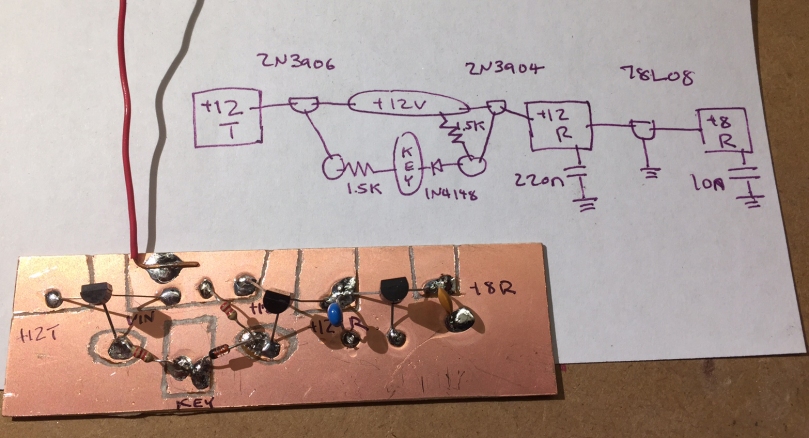A quick post from the day’s experiments: the transmit/receive power switching arrangement for my next project. The scheme is very much like that in the KN-Q7; I wouldn’t have stumbled across this (very simple) setup without an excellent write-up by Andrew Woodfield, Zl2PD.
Here’s the simple schematic:

The circuit itself is straightforward – when the “key” pad is left floating, current can flow through the 2k2 resistor attached to the 3904, providing a small base current and driving the 3904 in conduction and powering anything connected to the +12R pad. At the same time, there is nowhere for base current to flow in the 3906, so no current is provided to the +12T pad.
When the key pad is grounded (by a morse key, or other TR switching method), the base of the 3904 is pulled to ground through the small signal diode, and very little current will flow through the 3904 and into the +12R section, effectively killing receive functions. At the same time, a small current will flow through the 2k2 resistor attached to the 3906, allowing it to conduct and powering anything attached to the +12T circuit.
In short: when the key line is floating/disconnected, the circuit is powering receiver functions. When it is grounded, the circuit powers transmitter functions.
I added the little 7808 regulator to this power board, which will be powering some NE602 mixers on receive only. I put both circuits together on a little piece of copper-clad, in something like Island-Pads-meets-manhattan-construction:

I like how the layouts ends up showing off the inherent symmetry between PNP and NPN transistors. The whole thing looks quite nifty on the bench. I left the input and output pads deliberately large, to accommodate however many connections end up being made.
I did begin construction and testing on the next project, but was stymied by my SLA-battery power source running down (it was down to 7.4 out of 12V by the time I thought to put a meter on it). Rather than switch to the bench power supply (an old computer power supply with the 12V and 5V rails brought out), I took it as a sign to call it a night.
Hear you over the sizzle of solder!
74
